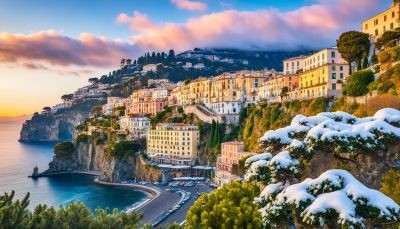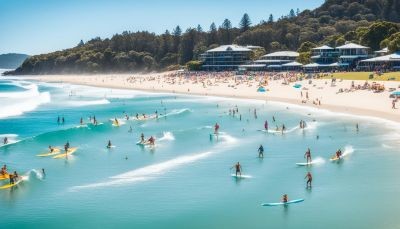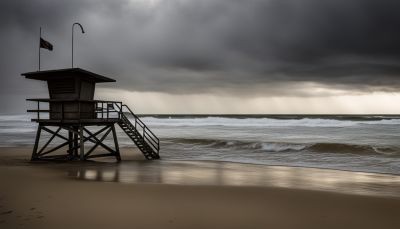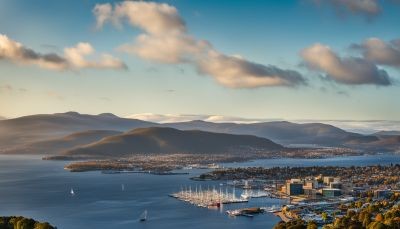Ever ask yourself when the perfect time is to see Venice, the beautiful city on water? Venice's Mediterranean weather and changing seasons can be tricky. They impact when it's best to plan your trip. Searching for the ideal time means considering ideal travel periods, temperature averages, precipitation, and humidity levels.
But here's a thought: what if you could find out how to have the best weather-wise adventure? Learn about the best months for visiting this gem in Italy. See when to avoid big crowds. Recognize peak seasons versus shoulder seasons. It'll help you enjoy your trip more.
Key Takeaways
- Venice has a subtropical climate with distinct seasons, including cold winters, warm springs, hot summers, and crisp falls.
- Rainfall averages around 30 inches per year, and the city's location on a shallow lagoon contributes to high humidity levels.
- The hottest months are July (83°F/28°C) and the coldest is January (45°F/7°C), with June being the wettest month.
- The weather in Venice can be unpredictable, so visitors should come prepared for anything.
- Understanding the best months to visit can help you avoid the crowds and maximize your enjoyment of this unique Italian destination.
Understanding Venice's Mediterranean Climate
Located in the Mediterranean, Venice has a special subtropical climate. The seasons change distinctly here. From cold, rainy winters to warm and pleasant springs, and hot, humid summers to crisp, sunny falls, it's always unique.Subtropical Climate with Distinct Seasons
Venice sits near the Adriatic Sea and a lagoon, shaping its Mediterranean climate. The seasons are clearly different, giving visitors diverse experiences. Whether you visit during the warmer months or the cooler seasons, knowing Venice's weather can enhance your trip.Annual Rainfall and Humidity Patterns
Venice gets about 30 inches of rain each year. Its shallow lagoon location makes for higher humidity. Snowfall is rare but can happen. Visitors should expect weather that changes quickly.Spring in Venice: Ideal for Sightseeing
Spring is the best time to visit Venice. The sun shines brighter and the days are longer. This season is perfect for exploring the city's canals, landmarks, and culture.Warm Days and Cool Evenings
In spring, Venice enjoys warm, sunny days and cool nights. Days are in the mid-60s Fahrenheit, or around 18 Celsius. Nights drop to the low 50s Fahrenheit, or around 10 Celsius. These temperatures are ideal for seeing the sights and enjoying outdoor areas.Peak Tourist Season After Easter
Spring marks the start of Venice's busy season, after Easter. Many visitors come from all over, excited to experience the city's unique charm and atmosphere.Events and Festivals in Spring
Spring is a time of celebration in Venice. Many festivals and events happen throughout the city. Notable dates include International Women's Day on March 8th, the Feast of San Marco on April 25th, and Labor Day on May 1st. These events let visitors join in the local culture and traditions.Packing Tips for Spring
For a spring trip to Venice, pack light and easy-to-layer clothes. Include pants, long-sleeved shirts, and a light jacket or sweater. Don't forget comfortable walking shoes. Most of Venice is best explored on foot.Summer in Venice: Hot, Humid, and Crowded
Summer in Venice means scorching heat and sticky air. The city gets very crowded. Days are often hotter than 95°F (35°C). This weather can be tough for anyone.High Temperatures and Humidity
Venice's location makes it even hotter than usual. The shallow lagoon adds to the sticky feeling. Finding shade or cool cafes might be necessary. It's a good escape from the heat.Crowded Canals and Premium Hotel Rates
Many tourists visit Venice in summer. The canals and streets get very crowded. Finding peaceful spots can be hard. Hotels also charge more, making a calm visit difficult.Venice Biennale and Festa del Redentore
Despite the downsides, summer in Venice has its perks. The Venice Biennale attracts global art fans. It's a great time to see top-notch art. July's Festa del Redentore boasts a stunning fireworks show. It's a special cultural event for all.Fall in Venice: Dwindling Crowds and Lower Prices
Autumn is a great time to visit Venice. The crowds are thinning, and prices for places to stay are lower. September might still be warm but it gets cooler at night. The first Sunday of September sees the Historical Regatta, a stunning boat parade and races on the Grand Canal.By October, the afternoons are crisp and the evenings cool. Don't miss the Festa della Salute on November 21st, marking the end of a 1631 plague. However, October and November is the time for acqua alta, where flooding is more common.
For a fall trip to Venice, pack layers. You'll need warm clothes and shoes that can handle rain.
Crisp and Sunny Days
Autumn in Venice is a break from summer's heat. The weather is perfect for exploring the city's sights.Risk of Acqua Alta (Flooding)
The fall in Venice is mild but there's a flood risk. Be ready with the right shoes for flooded streets. This prepares you for a fun trip despite the water.Historical Regatta and Festa della Salute
The Historical Regatta and Festa della Salute are key fall events. The Regatta is a grand boat parade. The Festa della Salute marks the plague's end in the 17th century.Packing for Fall Weather
Pack layers for your fall Venice trip. With warm pants, long tops, and good shoes, you'll be ready. This gear suits both sunny and rainy days.Venice, Italy: Best Months for a Weather-Savvy Trip
Winter in Venice: Cold, Rainy, and Quieter
Winter in Venice is cold and rainy, at times with snow. January is the coldest month. Expect temperatures between 46°F to 33°F, not counting wind chill. The city's filled with rain, snow, and high water that might flood the area. Despite the tough conditions, it's a less crowded time to visit.Carnevale: Venice's Biggest Festival
The Carnevale is Venice's grandest festival, held in winter. It marks the warm goodbye to the cold and rainy season. This celebration is a favorite for many, offering a chance to see Venice's rich culture.Packing for Winter Weather
For a Venice winter trip, pack your heavy winter gear. This should include a tough, water-resistant coat, warm hat and gloves, a thick scarf, and waterproof boots. Be ready for the city's cold, wet, and occasional flooding by the acqua alta.Month-by-Month Weather and Event Guide
Finding your way through weather and events in Venice can be fun. This detailed guide helps you plan your trip to Venice. It shows you when to go based on the weather and exciting events.| Month | Temperature | Rainfall | Daylight Hours | Notable Events |
|---|---|---|---|---|
| January | 46°F (7°C) to 33°F (1°C) | 2.4 inches (6 cm) | 9 hours | Carnevale (Carnival) |
| February | 48°F (9°C) to 36°F (2°C) | 2.2 inches (5.5 cm) | 10 hours | Carnevale (Carnival) |
| March | 54°F (12°C) to 41°F (5°C) | 2.4 inches (6 cm) | 11 hours | International Women's Day |
| April | 61°F (16°C) to 48°F (9°C) | 2.8 inches (7 cm) | 13 hours | Feast of San Marco |
| May | 70°F (21°C) to 55°F (13°C) | 2.4 inches (6 cm) | 14 hours | Labor Day |
| June | 79°F (26°C) to 63°F (17°C) | 3.5 inches (9 cm) | 15 hours | Venice Biennale |
| July | 83°F (28°C) to 68°F (20°C) | 2.8 inches (7 cm) | 15 hours | Festa del Redentore |
| August | 84°F (29°C) to 68°F (20°C) | 2.8 inches (7 cm) | 14 hours | Venice Biennale |
| September | 77°F (25°C) to 61°F (16°C) | 2.8 inches (7 cm) | 12 hours | Historical Regatta |
| October | 68°F (20°C) to 52°F (11°C) | 3.1 inches (8 cm) | 11 hours | Festa della Salute |
| November | 57°F (14°C) to 45°F (7°C) | 3.1 inches (8 cm) | 10 hours | Festa della Salute |
| December | 48°F (9°C) to 39°F (4°C) | 2.4 inches (6 cm) | 9 hours | Carnevale (Carnival) |
Avoiding the Crowds and Peak Seasons
Want to get away from the crowds and peak seasons in Venice? Try visiting during the shoulder seasons. In early spring and late fall, the weather is nice and there are fewer visitors. This makes your trip both peaceful and more budget-friendly.The winter months offer another chance to see Venice differently. Yes, it's colder and wetter. However, you'll enjoy fewer crowds and lower prices. This can be a unique time to explore the city at a slower pace.
Shoulder Seasons: Early Spring and Late Fall
Exploring Venice in early spring and late fall is a great idea. The weather is still nice. You can see the city's amazing sites and hidden spots more comfortably.Off-Peak Seasons: Winter Months
Winter season in Venice means fewer people and lower prices. The weather might be colder and wetter. Yet, the city feels more intimate and atmospheric. It's a perfect time to dive into its culture and join the famous Carnevale festival.Thinking about the shoulder seasons and off-peak months helps plan a good trip. You get to enjoy Venice's beauty and culture without so many people.
Insider Tips for Navigating Venice's Weather
When visiting beautiful Venice, be ready for its weather to surprise you. Acqua alta, or high water, is a phenomenon you should know about. Also, dressing in layers helps because the weather can change fast.Preparing for Acqua Alta (High Water)
The city is famous for its high water, when tides flood the streets. This happens when strong winds and low pressure come together. Water levels can go from small floods to big ones, making it hard to get around. Know how to check for warnings and have waterproof boots or waders ready.Dressing in Layers for Unpredictable Weather
Venice's weather loves to surprise, so wear layers to be ready. Choose clothes you can add or take off as needed. A warm, waterproof jacket, a sweater, and solid shoes are all smart to bring.By getting ready for acqua alta and wearing the right clothes for Venice's ups and downs, you can enjoy the city more. This will let you explore the hidden spots and create amazing memories in this special place.
Unforgettable Experiences in Venice
Venice is full of memorable moments for visitors. From famous festivals to hidden gems, the city has something for everyone. You might be into the colorful Venice festivals or prefer exploring quiet cultural spots. Either way, Venice will touch your heart.Attending Festivals and Cultural Events
The Carnevale festival, the Venice Biennale, and the Festa del Redentore are amazing. They make Venice burst with cultural pride. You'll see stunning costumes and enjoy delicious food. These events will stay with you forever.Exploring the City's Hidden Gems
Venice has many secret cultural spots beyond the usual sights. Discover lesser-known museums, quiet piazzas, and local artisan workshops. These hidden gems show Venice's true spirit and charm.Conclusion
Venice is a city like no other. Its beauty enchants all who visit. But, knowing when to visit matters a lot. The weather and seasonal changes can affect your experience. So, figuring out the best time to go and how to handle the weather is key. This way, you can make your trip to this famous Italian spot amazing.Venice shows a different side in every season. From the pleasant spring to the sunny fall, each time of year brings something special. You can visit in the less crowded times or even winter. Still, you'll enjoy its culture and find hidden spots easily, despite the weather.
Planning a trip to Venice means considering its unique weather. Use these tips to pick the perfect time to visit this Italian jewel. With some planning and flexibility, a fantastic journey awaits. Enjoy your time in this magical place.
FAQ
What is the overall climate of Venice, Italy?
Venice has a subtropical climate and very distinct seasons. Winters are cold and wet. Springs are warm and pleasant. Summers are hot and humid. Falls are cool and sunny. The city gets about 30 inches of rain each year.
The high humidity is because Venice is on a shallow lagoon. It rarely snows, and when it does, it doesn't last long.
What are the best times of year to visit Venice?
Spring is often thought of as the best time to go. Days are long and sunny, with cool evenings. It's the start of the busy tourist season, which begins after Easter.
Autumn is great too, with fewer people and cheaper places to stay. Yet, this is also when flooding is more likely.
What should I consider when visiting Venice in the summer?
Summer in Venice gets very hot and humid. Temperatures can be over 95°F (35°C). It's also the most crowded time, with high hotel prices and packed canals.
The weather can be intense, and sometimes the canals smell bad. But, there are events like the Venice Biennale and Festa del Redentore, with fireworks, in July.
How can I avoid the crowds and peak seasons in Venice?
The best times for fewer tourists and better prices are early spring and late fall. The weather is still nice, and there are not as many people. Winter means colder and rainy days, but it's the least crowded time.
What should I know about the weather in Venice?
Venice's weather can be tricky, with sudden changes. Acqua alta, or high water, can flood some places. Knowing how to deal with this is important.
Dressing in layers is smart because the weather can go from hot to cold quickly. This helps you stay comfortable.











